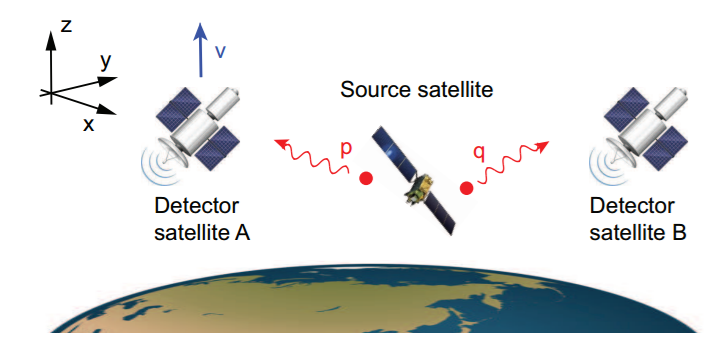Relativistic quantum information
Relativistic quantum information
One of the key quantum technologies that is in current development worldwide is the quantum communications network. In a quantum network, individual quantum nodes have capabilities of storing and/or manipulating quantum information. These are then interconnected using quantum channels, such than quantum information can be exchanged between the nodes. Such a quantum network can be viewed as a natural extension of quantum key distribution (QKD) networks which exist today, which predominantly consist of the quantum channels without quantum memories at the nodes. In order for quantum networks to gain widespread commercial use, ideally it should be possible to support large distances between nodes. The key technological and commercial centers of the world are spread worldwide, hence connections over intercontinental distances are desirable, with nodes separated by several thousands of kilometers. This distance is one of the major technological challenges facing the creation of a large-scale QKD and quantum networks. The most convenient way of transmitting quantum information is using optical fibers. However, it is well-known that due to the exponential scaling of loss with distance, the upper limit is of the order of several hundred kilometers.
Figure 1: Configuration for entanglement distribution using satellites from Ref. [1].
One attractive possibility to overcome these issues is using space-based quantum communication. In this scenario, satellites orbiting the Earth would act as nodes of the quantum network, which could store, send and receive quantum information. At altitudes where satellites orbit the Earth, photon loss due to scattering is negligible, and photons can propagate across extremely long distances. The main loss in this case is caused by diffraction, due to the finite diameter of the receiver and transmitter. For example, using reasonable diameters it is in the region of 40dB loss for Low Earth Orbit (LEO). Involving ground-based quantum network nodes is also not an inherent problem as 80% of the atmosphere by mass is located within the first 12km in altitude. Ground-to-satellite quantum communication has already been demonstrated, as will be discussed more in the next section. Such a satellite-based quantum communication system is naturally suited to various tasks, in particular quantum cryptography which does not require quantum memories. But with the addition of quantum memories the capabilities of such a quantum network could be greatly enhanced, making many of the applications listed above a possibility at the global scale.
Naturally, such a space-based quantum network comes with enormous challenges that much be overcome before it is implemented. Creating even a short-distance quantum network is currently technologically challenging, let alone one that is loaded onto a satellite transmitting photons across distances potentially of the order of the diameter of the Earth. The cooperation of space agencies is necessary even for initial experiments. However, as we describe more in the next section, the 2016 launch of the quantum communication satellite by China has the made development of this technology an immediate and crucially important task that must be addressed in parallel to more terrestrial approaches. In this project, we aim to bridge the current technological state of the art towards the realization of a global space-based quantum network.
References
[1] Tim Byrnes, Batyr Ilyas, Louis Tessler, Masahiro Takeoka, Segar Jambulingam, and Jonathan P. Dowling, arXiv 1704.04774.

